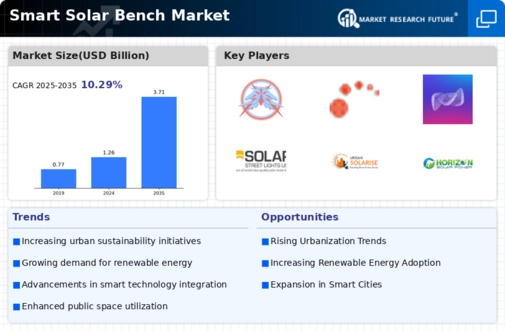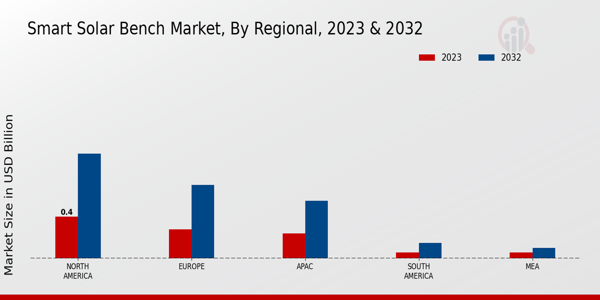Market Growth Projections
The Global Smart Solar Bench Market Industry is poised for substantial growth, with projections indicating a market value of 1.26 USD Billion in 2024 and an anticipated increase to 3.71 USD Billion by 2035. This growth trajectory suggests a compound annual growth rate of 10.3% from 2025 to 2035, highlighting the increasing adoption of smart solar benches in urban environments. The rising demand for renewable energy solutions, coupled with supportive government policies and technological advancements, is likely to drive this expansion. As cities continue to prioritize sustainability and smart technology integration, the market is expected to flourish.
Government Incentives and Policies
Government incentives and policies play a crucial role in the expansion of the Global Smart Solar Bench Market Industry. Many governments are implementing regulations and financial incentives to promote the adoption of renewable energy technologies. These initiatives often include grants, tax credits, and subsidies for projects that incorporate solar energy solutions. As a result, municipalities are more likely to invest in smart solar benches, which not only provide energy solutions but also enhance public spaces. The anticipated compound annual growth rate of 10.3% from 2025 to 2035 underscores the positive impact of these supportive policies on market growth.
Urbanization and Smart City Initiatives
Rapid urbanization is a significant driver of the Global Smart Solar Bench Market Industry. As urban populations grow, cities are investing in smart city initiatives that prioritize sustainability and technological integration. Smart solar benches serve as multifunctional urban furniture, providing not only seating but also energy solutions. This trend aligns with global efforts to create more livable, eco-friendly urban environments. The market is expected to expand significantly, with projections indicating a growth to 3.71 USD Billion by 2035, as municipalities increasingly adopt smart solutions to enhance urban living.
Technological Advancements in Solar Energy
Technological advancements in solar energy are significantly influencing the Global Smart Solar Bench Market Industry. Innovations in solar panel efficiency, energy storage, and smart technology integration are making solar benches more effective and appealing. These advancements enable benches to provide reliable energy sources for charging devices and powering integrated smart features. As technology continues to evolve, the functionality and appeal of smart solar benches are likely to increase, attracting more investments and installations in urban areas. This trend is expected to contribute to the market's growth trajectory, aligning with the projected increase to 3.71 USD Billion by 2035.
Rising Demand for Renewable Energy Solutions
The Global Smart Solar Bench Market Industry is experiencing a surge in demand for renewable energy solutions as cities and municipalities seek sustainable alternatives to traditional energy sources. This shift is driven by increasing awareness of climate change and the need for energy efficiency. Smart solar benches, which harness solar energy to provide charging stations for electronic devices, are becoming increasingly popular in urban areas. By 2024, the market is projected to reach 1.26 USD Billion, reflecting a growing commitment to integrating renewable technologies into public infrastructure.
Environmental Awareness and Sustainability Trends
Growing environmental awareness and sustainability trends are pivotal in shaping the Global Smart Solar Bench Market Industry. As communities become more conscious of their ecological footprint, there is a heightened demand for products that promote sustainability. Smart solar benches, which utilize renewable energy and reduce reliance on fossil fuels, resonate with this shift in consumer preferences. This trend is reflected in the increasing number of installations in parks, public squares, and urban centers. The market's growth is indicative of a broader movement towards sustainable urban development, with expectations of reaching 1.26 USD Billion by 2024.











